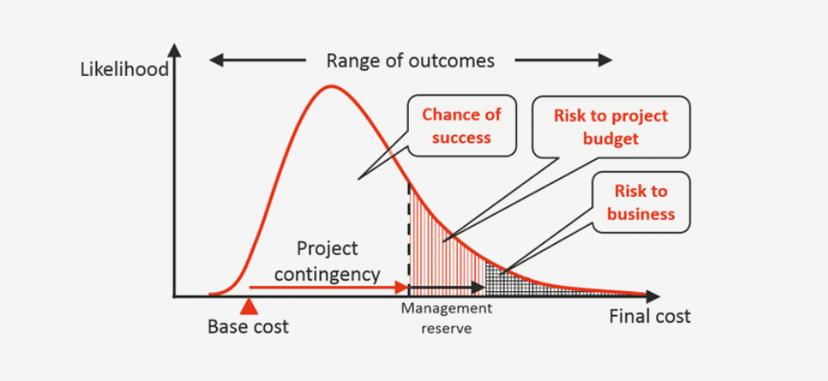
Click the button to start reading
Sick and Tired of Missing Deadlines? How to Use the Monte Carlo Analysis in Project Management
Have you ever promised someone you’ll meet them for dinner at 7:00, and a little voice inside your head knows it’ll be a close call?
Suppose it’s a Saturday, and you have a pile of errands to run: change the oil, get gas, buy groceries, drop your coat at the dry cleaner, turn in library books and visit your mother-in-law.
Even if you’ve done all these things a thousand times and know how long each should take, a variety of factors could throw you off. Maybe you’ll hit a traffic jam or run into long lines at the store, and leave your friend waiting alone at a dinner table, sipping a glass of ice water.
A complex project runs up against this same sort of conundrum. There’s always pressure to commit to a budget and a completion date. But when the project consists of hundreds of complex tasks, it’s a real challenge determining these values.
The Monte Carlo analysis is a project management technique for handling this sort of complexity. Don’t be fooled by the title: it’s not about trickery and sleight of hand. Rather, it’s a robust mathematical equation that carefully considers data from similar projects to provide estimates for the project at hand.
If you’re looking to minimize risk in your projects, then Monte Carlo may be just the solution. But applying it is a bit of a challenge. Let’s look at the ins and outs of the Monte Carlo analysis, and see where it fits into a risk management plan.

The History of the Monte Carlo Analysis
Monte Carlo is a resort in the micro state Monaco, located at the base of the Maritime Alps. It established casinos in the 1860s, and, with the addition of an opera house and sporting club over the next 50 years, became a luxury destination with picturesque villas overlooking the Mediterranean Ocean.
The resort has become synonymous with gambling, and two card games bear its namesake: a game of solitaire and three-card Monte, which uses three face-down cards and usually involves sleight of hand.
In the 1930s, Stanislam Unam, a scientist working in Los Alamos as a part of Manhattan Project, reflected on the probabilities in a game of solitaire. His reflections developed into the equations that became the basis for the method, which he assigned the code name “Monte Carlo,” as it was a favorite gambling destination of his uncle.
Over the following decades, several mathematicians honed the method into the simulation that’s used today.

A Definition of the Monte Carlo Analysis
A Monte Carlo analysis or simulation is part of a risk management plan. It’s used primarily to create estimates around a project’s duration and its cost.
Here is how the Project Management Glossary defines it: “Monte Carlo simulation is a computer-based technique that performs probabilistic forecasting of possible outcomes to facilitate decision making. For each possible decision — from the most high-risk to the most conservative — a Monte Carlo simulation provides decision makers with a range of possible outcomes and the likelihood that each will occur.”
The Monte Carlo analysis is highly mathematical, and provides a range for a project’s duration or cost, as well as probabilities for each outcome.
The method is fairly complex and isn’t always necessary for a project. However, in certain instances it can effectively pinpoint a project’s probable cost and duration.
Let’s look at the four steps to take in order to apply this simulation in a project.

The Four Steps to Run the Simulation
When a project consists of many complicated tasks, the Monte Carlo method helps to determine both its completion date and cost. Here are the steps for using the method on a project.
1. Determine the Critical Path
The first step is to sequence all of the project’s tasks and determine the critical path. Those tasks on the critical path are the focus of the Monte Carlo Method.
2. Estimate Each Activity on the Critical Path
Next, carefully consider the risks and uncertainties surrounding each critical activity, and determine a range of estimates for the duration or cost of each. Additionally, assign a probability to each value on this range.
For example, if an activity takes one, two, or three hours, determine the likelihood of each value. If it’s most likely to take two hours, this value is assigned the highest probability.
In order to determine these values with precision, it’s essential to have extensive experience in the specific task at hand. Speculating about the duration or costs of unfamiliar tasks can lead to inaccuracies, rendering the analysis useless.
3. Enter Estimates into the Monte Carlo Equation
As a final step, enter these values (time or cost plus probability) into a Monte Carlo equation. As this equation is complex, it’s necessary to do this using software; it cannot be calculated by hand.
The simulation then calculates a distribution for the duration or cost for the entire project, and assigns probabilities to each outcome.
4. Forecast the Project’s Duration or Cost
Using the distributions provided by the simulation, it’s possible to come up with a solid estimate for the project’s cost or duration.
Most values cluster around the predicted schedule or cost, and the 70-80% probability range yields a value that the project is likely to either smash or go below.
With these steps in mind, let’s look at an example for how this works.

Example of a Monte Carlo Analysis
Whether estimating a project’s cost or its duration, the Monte Carlo analysis works almost identically. Let’s look at how to build a distribution for the project of installing a kitchen backslash. These are the various durations for twenty previous installations:
2 installations: 1 hour or less
10 installations: 1 to 1.5 hours
5 installations: 1.5 to 2 hours
3 installations: 2 to 2.5 hours
In these twenty examples, the second value occurs the most frequently; in ten out of twenty times, the installation took between 1 and 1.5 hours. As ten is half of twenty, a project manager is 50% certain that an upcoming installation takes the same amount of time.
Suppose a project manager wants to have 85% certainty around the time estimate for the backsplash installation. With 20 samples, 85% represents 17 samples, which is the sum of the first 3 values. He or she can assign an estimate of two hours to the installations and be 85% certain of its accuracy. Being 100% certain means assigning the highest estimate of 2.5 hours.
Note that this is a simple project consisting of only one task. A kitchen remodel normally includes many, many more tasks, including installing counters, cupboards, a refrigerator and a stove. Calculating the duration for a complex project with multiple tasks requires using software with a Monte Carlo simulation.
Calculating cost uses the same process, except the estimated values are cost and probability rather than time and probability.
In summary, when estimating both cost and schedule, the Monte Carlo Method entails breaking the project down into individual activities, and assigning a range of values with corresponding probabilities for each.

Strengths & Weaknesses of the Simulation
Monte Carlo provides answers to pressing project questions, no doubt about it. In addition to providing estimates around cost and timeline, it also allows project managers to identify how much cushion they have around a slated budget and schedule.
But is Monte Carlo a solid method? Can a project manager lean in on the results from these calculations?
In order to use the process effectively, it’s necessary to understand both its strengths and its weaknesses. Let’s look at the strengths first.
Strengths
Provides Objective Analysis
The Monte Carlo analysis considers all of the activities on a critical path, giving them equal weight. This is very difficult to do on our own. Rather, it’s easy to have a myopic fixation on one activity and overlook others.
Provides Flexibility
The Monte Carlo simulation provides project managers with a range, given the inputs. A project manager can change the data to discover other ranges. Playing around with the calculated values and identifying various ranges helps to eliminate risk, as the project manager understands what he or she is getting into under various scenarios.
Weaknesses
Requires Lots of Data
The values in a Monte Carlo simulation are the most reliable when they’re taken from previous experience. To obtain these values, it’s necessary to have performed a similar project many times before.
If a team is doing a task for the very first time, or has only done it a few times, it’s impossible to come up with accurate ranges for the time or cost.
The principle “Garbage in, Garbage Out” applies here. If the numbers going into a Monte Carlo simulation are inaccurate, then the values that come out won’t be reliable.
Does Not Consider Correlation Between Tasks
Monte Carlo ignores something that’s clear to any project manager: tasks are correlated, and many tasks are similarly affected by the same uncertainties.
Take a construction project that’s heavily influenced by the weather. A snowstorm would severely impact the initial task of laying the foundation. The upcoming task of framing the house would be similarly delayed by this same snowstorm.
However, a Monte Carlo simulation doesn’t take this into account. It considers each task individually, and doesn’t consider the impact of one event on all the tasks collectively.
Requires a Huge Time Commitment
A Monte Carlo simulation entails looking at each individual task, and creating an estimate. In a project with several dozen tasks, coming up with these values takes some time. This is time dubiously spent, given that many of the inputs may not be accurate.
In conclusion, a Monte Carlo analysis can be a helpful part of a risk management plan. But it shouldn’t be used exclusively, but rather in combination with other methods and techniques.
Conclusion
Particularly in a long project with dozens of tasks, coming up with solid estimates for a project’s cost and schedule is no piece of cake.
The Monte Carlo analysis provides a solid mathematical approach to estimating both the length and cost of a project. Although it isn’t foolproof, it can be a helpful part of a risk management plan.
If you’re looking to stay on top of project schedules and costs, then visit Teamly, the intuitive project management software designed for distributed teams. Check us out today!?
















